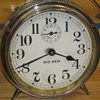Posted 14 years ago
 bigben
bigben
(72 items)
This Gilbert “Parole” shelf or parlor clock was made about 1880. The walnut case is 19 1/4 inches tall. The paper dial and hands are original, as are the pendulum and the glass in the door. It has an 8 day time and strike movement with stopworks. There is an alarm unit mounted separately in the case (below dial, to the left). The disc in the center of the dial sets the alarm. There is no alarm shutoff.
















I just purchased a clock almost the same as one pictured, but it has a diffrent glass picture and no alarm is it still a parole... do you have a value est..?
I inherited a Gilbert clock from my mother that was my Great Grandmother's. It is a Gilbert "Medea" clock and has the same mechanism as your clock including the alarm My mother use to wind it once a week when I was a child but I was not allowed to touch the mechanisms.
So while cleaning it the other day, I decided to be brave and to try to wind it and get it started. There are the two places in the clockface, the one to the left seems to wind clockwise, the one to the right counter clockwise. There is also the place on the left side below the clockface next to the pendulum/bell that I wound with the smaller key. I called my brother. He said he thought I was only suppose to wind one of these places. Can you help me know how to properly wind this clock? Also, do you know how the alarm functions. I didn't even know that it had an alarm function, but it went off while I was resetting the time. And then while trying to look this clock up on the internet, I see that some of these clocks like yours were equipped with alarms. Although you mention in your notes that the disc in the center sets the alarm, I still don't get it.
On these two abor clocks, facing you the abor (winding stem) on the right winds the time, the one on the left winds the strike.
You can not stop the alarm mechanism, so wind it half or a third of the way to shorten it's ringing.